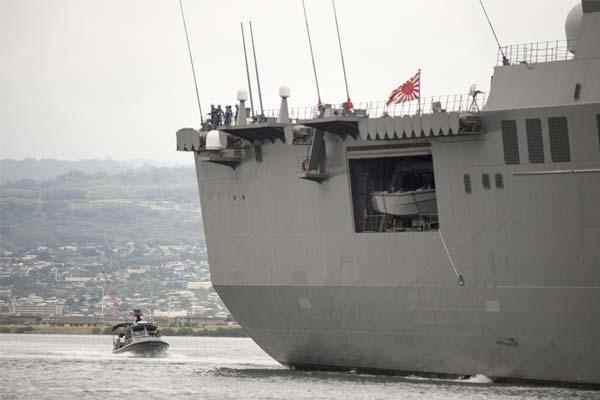The 646-foot flattop that Japan lists as a destroyer and China calls a helicopter carrier will join training exercises in the South China Sea next week to send a "strong message" to Beijing on its sovereignty claims over disputed islands and reefs, an official said.
The first deployment of Japan's Maritime Self-Defense Forces warship Ise outside of Japan's home islands will include a port stop at Subic Bay in the Philippines, where about 5,000 U.S. troops and 3,500 Filipino troops began the Balikatan 2016 live-fire exercises earlier this week that will continue through April 15.
Defense Secretary Ashton Carter, along with officials of Japan, Australia, Vietnam and other regional nations, was expected to stop in the Philippines next week to observe the Balikatan exercises ahead of his April 10-12 meetings in India to bolster military cooperation and sales.
In a news conference earlier this week at Camp Aguinaldo, headquarters of the Philippines' Armed Forces, Lt. Gen. John A. Toolan, commander of U.S. Marine Forces, Pacific, said that there were "a couple of things he (Carter) is very interested in" -- an apparent reference to the first firing in the Philippines of the High Mobility Rocket System (HIMARS) made by Lockheed Martin Corp.
The stepped-up ground, air and naval exercises by the U.S. and its allies in the region reflected the growing tensions brought on by China's aggressive actions and construction of artificial islands and airstrips in the South China Sea.
Japan's maritime forces said that the Ise, which left port in Japan late last month, will also participate in the Komodo naval exercises with regional allies led by Indonesia later this month.
In meetings with President Barack Obama in Washington, D.C., last week, Chinese President Xi Jinping warned that China would not accept violations of its sovereignty in the South China Sea in the name of "freedom of navigation."
Carter has frequently warned that China is "self-isolating" by its actions in the South China Sea. Last month, the secretary said that he was "re-assessing" the invitation for Chinese warships to attend the bi-annual RIMPAC, or Rim of the Pacific, naval exercises scheduled to begin in June off Hawaii because of its actions in the South China Sea.
Last Sunday, the Japanese submarine Oyashio and two surface warships arrived at Subic Bay. It was the first port visit by a Japanese submarine to the Philippines in 15 years.
The scheduled arrival in the Philippines of the Ise was "aimed at promoting friendly relations, but it also includes a strong message to keep China in check," a senior Japanese Defense Ministry official was quoted as saying by Japan's Yomiuri Shimbun newspaper.
The Ise can carry 11 SH-60J/K Seahawk anti-submarine helicopters but Japanese media have frequently noted that the Ise could easily be adapted to serve as a platform for U.S. Marine MV-22 Osprey tilt-rotor aircraft and the F-35B, the vertical takeoff and landing Marine version of the Joint Strike Fighter.
Referring to the Balikatan exercises and the "freedom of navigation" naval exercises by the U.S. and its allies in the South China Sea, Chinese Foreign Ministry spokesman Hong Lei said that "a provocation so fear-mongering and untimely is likely to boomerang on the initiators," adding that military exercises should "promote regional peace, stability and development, instead of the contrary," according to Xinhua, China's state news agency.
Hong also said that "Japan once illegally occupied China's islands in the South China Sea during World War II. We are on high alert against Japan's attempt to return to the South China Sea through military means."
Under Japan's pacifist 1946 Constitution, which was drafted by the U.S., Japan's military was limited to "self-defense" but legislation passed last year with the backing of Prime Minister Shinzo Abe allowed Japan to participate with allies in "collective security."
Critics charge that the Ise, which resembles U.S. amphibious assault ships carrying Ospreys and jump jets, was listed as a "destroyer" to get around the prohibitions on Japan's military participation in "offensive" operations.
-- Richard Sisk can be reached at Richard.Sisk@Military.com.






























